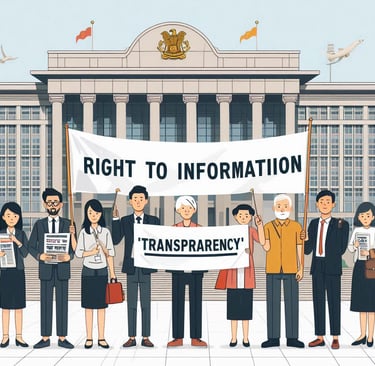Right to Information (RTI) And Transparency
Mohini Pandey
Deen Dayal Upadhayay University Gorakhpur
This Blog is written by Mohini Pandey, a Law Graduate of Deen Dayal Upadhayay University Gorakhpur


INTRODUCTION
The right to information is the fundamental right under Article 19 (1) of the Indian constitution. It is mentioned in the case of RAJ NARAIN VS STATE OF UTTAR PRADESH that the right to information is under Article 19.
In this supreme court held that in India people are supreme and assumed to be masters so they have the right to know about the workings of the government.
Therefore, the government enacted the right to information in 2005 which provides machinery for exercising this fundamental right.
The objective of the Right to Information Act is to empower the citizens of the country to question any work done by the government and its policies. This has been used widely by the citizens of the country in many ways like corruption, progress in government work, expenses-related information, etc.
The main aim or goal of the Right to Information Act is given below
· Empower citizens
· Promote openness
· Accountability in government operation
· And make our democracy function for the people.
The RTI helps the citizen to get information and keep track of that information through government instruments and holds them responsible for their work.
And all governmental authorities or partially governed authorities come under this act. The act imposes penalties if the authorities delay in responding to the citizen in the given time.
FEATURE OF RIGHTS TO INFORMATION AND WORKING PROCESS
The RTI process involves the reactive disclosure of the government authorities. The Right to Information Act's main objective is to provide information that is needed by the citizens.
Information means it can be any form of information like any form of record, document, email circular, press release, contract, a sample of electronic data, etc.
Each public and partial public authority appoints a public information officer (PIO) and an assistant public information officer (APIO) to provide information to the public. Any individual can request or apply to PIO to get any type of information. And they have to provide the information in the given time otherwise they have to pay the penalty mentioned in the act.
The application fee for the applicant is 10Rs and if that person is poverty line then it is free for that person.
RIGHT TO INFORMATION ACT EXEMPTS THE FOLLOWING ORGANISATION
There are 25 government organizations exempted from purview under the second schedule of the RTI Act.
The agencies are the central economic intelligence bureau, intelligence agencies, and research bodies working with country security agencies are also immune from the act as are paramilitary forces.
IMPACT OF RIGHT TO INFORMATION ACT ON ADMINISTRATION
The right information is one of the friendliest legislations. A large number of people are benefited from the act because it provides transparency to the person who wants to know anything.
And because every individual has this right to know authority, they can ask for every little detail that they want but many organizations are exempted from this act so they cannot ask from them but other than them they can ask for it.
The right to information is also known as the right to know.
It is very helpful for getting all the information on the functioning of the public authorities, and disclosure of information regarding government rules. All the government authorities are mandated to maintain all records to provide it whenever needed by the public on time.
CONCLUSION
The Right to Information Act has been made to achieve social justice transparency and to make accountable government.
The government wants to provide transparency to citizens about the government work and the work of public authorities.
It is well recognized that the right to information is necessary but not sufficient to improve governance. Right to information is beneficial for the citizens as well as for some government authoritative persons also to get information about the authorities well.
It is not fully successful but tried well to provide all sufficient needs of the citizens and it is made for the people of the country.
· REFERENCE
2. https://www.transparency.org
3. http://www.rti.img.kerala.gov.in ›
4. https://www.drishtiias.com ›
5. BYJU’S
6. https://rti.gov.in ›
